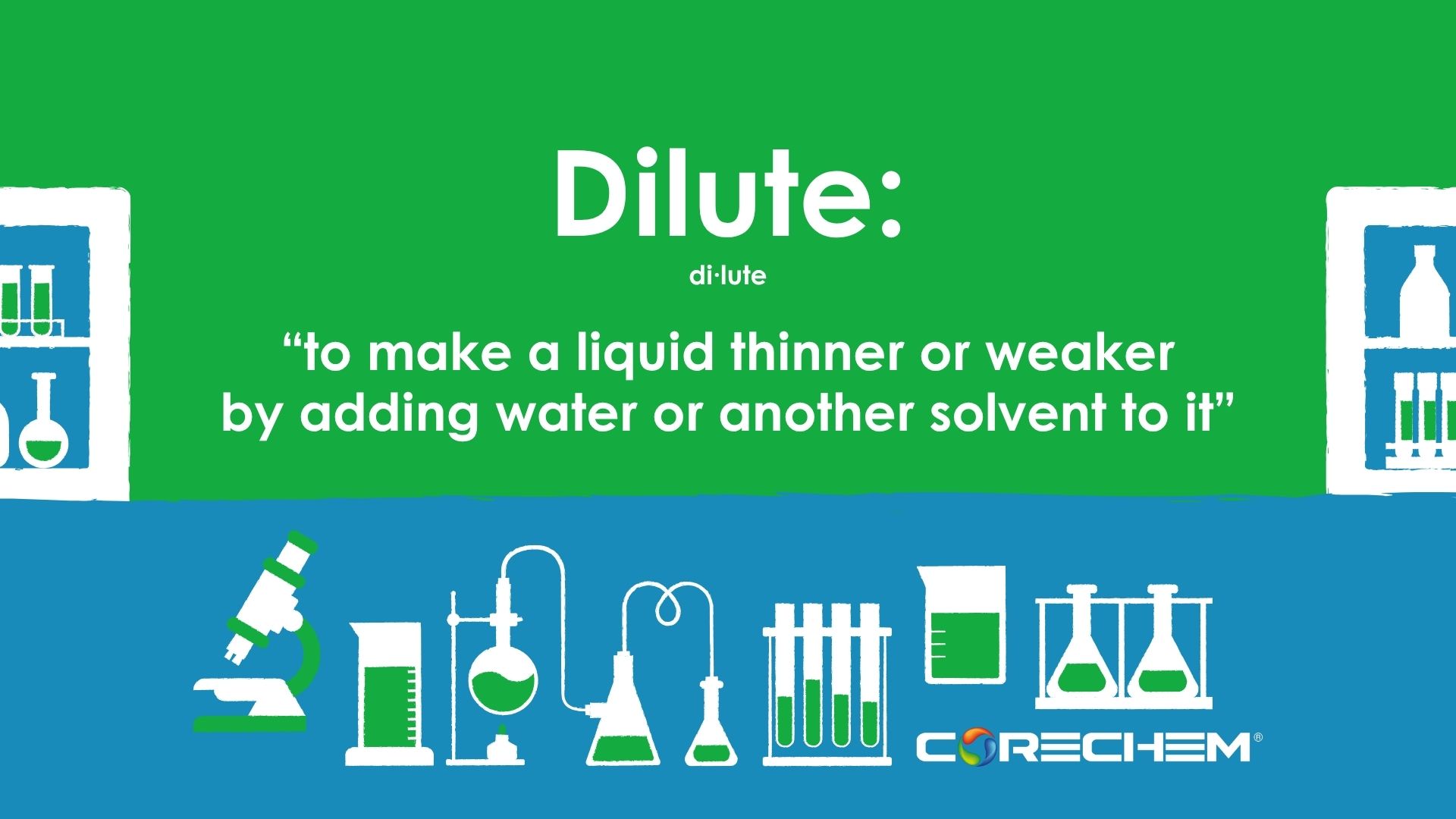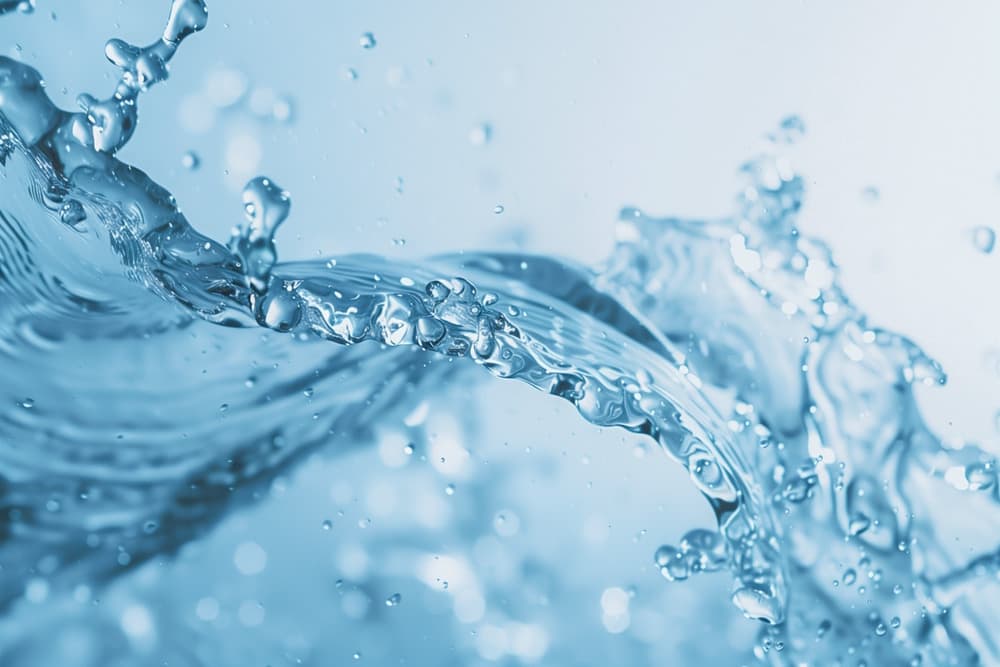
‘Dilute’ is a word that can be used correctly as an adjective or as a verb. In simple terms, it means to ‘make a liquid thinner by adding water or another solvent to it’. A ‘dilute solution’ is one in which the concentration of the original liquid is reduced- typically because a significant amount of water has been added to it. Synonyms for ‘dilute’ may include: reduced concentration, watered-down, thinned, or less-concentrated.
.
In this article:
- Purpose of Dilution
- Types of Dilution: Simple vs Serial
- How to Dilute
- Dilution vs. Concentration
- Examples of Dilutions
.
Purpose of Dilution
The purpose of dilution is to weaken the strength of products. In chemistry, this may be needed in applications where the full-strength concentration is too strong. For example, Glacial Acetic Acid is a fully concentrated chemical that would be very hazardous for homeowners to use. Dilute it to a 4-7% concentration, and homeowners can safely buy and use it in their homes. This dilute version is commonly known as ‘Vinegar’. By reducing the concentration of active ingredients, we can ensure that the end-use concentration is appropriate for the task at hand. Another reason why dilution may be used is to make products last longer or go further.
There is a use for dilution that may be rightfully viewed as ‘deceptive’. Manufacturers can use dilution to add bulk to products. For example, water added to a pill to make a larger soft gel pill may leave consumers with the impression that they are buying more than they actually are. Products can be built into retail goods such as lotions, shampoos, etc. as ‘builders’ or ‘extenders’. In situations where it matters, check the integrity of the manufacturer if possible.
Is it possible to dilute a dry product? Yes, you can technically ‘dilute’ dry products; however, this would usually be called by another name. Dissolving dry products in water would dilute them- but this is often called ‘creating a solution’. ‘Diluting’ a dry product with another dry product would normally be called ‘blending’.
Types of Dilution: Simple vs. Serial
There are two types of dilution: simple dilution, and serial dilution. The difference is easy to understand: in a simple dilution, product is diluted in a single-step process, while a serial dilution is a multi-step process.
What is the point of a serial dilution? Why do it in multiple steps, when it would be so much easier to do it in a single step?
Due to the nature of some products (especially chemicals), a single-step dilution could produce an extreme amount of heat, that is dangerous. For example, Sodium Hydroxide and Sulfuric Acid (extreme acids and bases) can give off hundreds of degrees of heat almost instantly- hot enough to boil the water, and hot enough to melt equipment that may be used to handle the liquid. In the eyes of the EH & S, this is a huge safety concern. To reduce the amount of heat given off, a serial dilution may be performed.
With an end goal of 10% Sulfuric Acid, Sulfuric Acid 93% may be reduced first to 78%. Then, that can be reduced down to 65%. Later, that may be reduced down to 50%– and so on. In addition to reducing the safety threat, each of these products can also be viably used on their own. A serial dilution can create multiple useable products along the way.
How to Dilute
Typically, a liquid can be diluted by mixing it with a significant volume of some other liquid. If diluting with water, the water would normally be simply poured into the liquid. If diluting with some other solvent, the same procedure may often be used.
As discussed above, there are certain products/situations that may require a more complex procedure for safety and other concerns. A robust understanding of the liquids you are trying to mix is necessary. Only persons properly trained and knowledgeable about the procedure should attempt these types of dilutions.
Mixing is necessary for dilution. Keep in mind that some liquids, such as oils, may not always be miscible with water or other liquids. Liquids that do not mix together typically will not be able to be used for dilution purposes by most people.
In order to dilute, the volume of water or other liquid must be significant when compared with the volume of the liquid. A single teaspoon of water poured into a full 55-gallon drum of product will not be significant enough to dilute the product in the drum. Some persons may choose to use the term ‘dilute’ to refer to product that is at a truly very low concentration (i.e. Acetic Acid 10%, rather than 56%).
Dilution vs. Concentration
The most dilute solution is the one with the lowest amount of the liquid that is being diluted that is still at a detectable level. The opposite of a diluted product is a full-strength, 100% concentrated product.
Funnily enough, the words can also be used interchangeably. It would be correct to refer to a product as being available at either a “50% dilution” OR “a 50% concentration”.
Other words for “not diluted” include: “Full strength”, “Concentrate”, “Full Concentrate”, and “100% Concentrate”.
Examples of Dilutions
One household example of a dilute solution may be adding water to milk or juice (i.e. for a toddler). Industry examples would include the various chemicals we’ve discussed in this blog. (i.e. the term ‘dilute acid’ refers to acid that has had water added to it until it’s at a weak concentration).
If you’re wondering whether or not something can be diluted (most typically, with water), it usually can be – if it is water-based. “Should I dilute it?” may be a more appropriate question – since diluting some things (i.e. inks, paints, etc.) may make them ineffective for what they are meant to be used for.
For more questions on dilution for industrial applications, or how to dilute a particular chemical, reach out to a representative! CORECHEM offers many chemicals pre-mixed to a wide range of concentrations, well-suited to meet a wide variety of industrial needs. We look forward to speaking with you!

